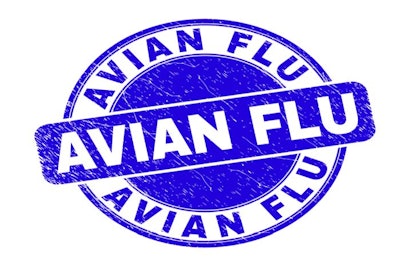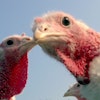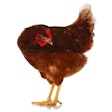
Rapid developments in the highly pathogenic avian influenza (HPAI) situation in France have led the agriculture ministry to raise the disease alert level from “low” to “moderate” at the end of last week. As a result of rising mortalities in both commercial poultry and wild birds, preventative measures will be reinstated.
During the summer, cases dwindled to lower levels although — unlike in previous years — new cases continued to be reported in France over those months. In recent weeks, deaths of wild birds have risen to “several hundred,” the ministry reports, even before wild bird migrations reached their seasonal peak.
Of particular concern are the 18 confirmed outbreaks on French poultry farms since August (as of September 29). Affecting birds in 11 departments, these indicate the persistence of the H5N1 HPAI virus serotype in the environment, according to the ministry.
Last week, the European Commission approved payment of EUR15.4 million (US$15.1 million) in state aid from the French government to poultry farmers impacted by HPAI during the 2022-2023 season.
Frances introduces new disease control zone
Among the new control measures in place in France are a requirement to house poultry in high-risk areas. This covers wetlands, and those crossed by migration corridors, particularly for waterfowl such as ducks and geese in areas of high poultry density.
Furthermore, testing of farmed waterfowl is being ramped up in these areas.
In addition to the 3-km protection zone and 10-km surveillance zone around each outbreak, there will be additional requirements within a 10-20-km radius of an outbreak. In this area, poultry will need to be confined, regularly checked for HPAI. In addition, placement of birds will only be allowed after the premises passes a biosecurity audit.
Following confirmation of an outbreak, hunting activity in the area will be restricted.
Last but not least, a 20-km temporary control zone will be effected around any HPAI case in wildlife. Within this area, poultry must be confined, and additional HPAI testing carried out.
Since the first cases of HPAI in France in November of 2021, 1,393 outbreaks linked to the H5N1 virus variant have been reported officially to the World Organisation for Animal Health (WOAH). Directly impacted have been more than 16 million commercial poultry, as well as over 2,000 backyard birds and 1,000 wild birds.
Over the past three weeks alone, 10 farm outbreaks impacting more than 198,000 birds have been confirmed to WOAH by the French veterinary body.
Western European nations see rising HPAI cases in poultry
The early start to the HPAI season is not only a concern in France.
Over the past three weeks, eight new outbreaks involving a total of over 400,000 poultry have been reported to WOAH by the Netherlands.
In the German state of Lower Saxony, almost 87,000 poultry have been impacted in four new outbreaks.
In the United Kingdom (U.K.), four outbreaks during September took the total over the past 10 months to 101. Numbers of the country’s poultry directly affected through mortality and preventative culling now exceeds three million.
Latest to test positive for the H5N1 HPAI virus in Belgium have been around 213,000 poultry at three farms in one East Flanders town.
In Spain, the virus was detected in two more flocks of laying hens totaling around 752,000 birds in early September. Affected farms were both in the province of Guadalajara in Castilla-La Mancha. These were the first H5N1 cases on this central Spanish autonomous region.
First HPAI outbreaks of the autumn/fall have been reported in Italy and Poland.
Having declared the previous HPAI series closed in April this year, the Italian veterinary authority registered the country’s first outbreak of the season to WOAH in September. Presence of the H5N1 virus serotype was confirmed after 10 birds died at a farm in the northwestern region of Veneto.
In Poland, there was just one month between the closure of a previous HPAI outbreak series and the detection of the first H5N1 cases in the central province of Lodz.
According to the nation’s chief veterinary office, a spike in mortality was observed among the 1,643 meat geese and 43 hens at the infected farm.
Overall situation in commercial poultry flocks
As of September 25, 1,844 HPAI outbreaks have been recorded across Europe so far this year. This is based on the latest update of the Animal Disease Information System by the European Commission (EC). The total represents an increase of 32 outbreaks since September 5.
To date, one or more outbreaks have occurred in 21 European countries since the start of 2022.
Since the start of September, Serbia has been added to this list with three confirmed outbreaks.
For comparison, this season’s figure has passed the total of 1,756 outbreaks registered with the EC by 24 European states over the whole of 2021.
This year, France has been the nation reporting the most outbreaks to the EC (1,363). Next came Hungary (205), the Netherlands (57), Germany (53), and Poland and Spain (each with 36).
Rising cases among Europe’s backyard flocks
In its reporting system, the EC has recently introduced a separate category for HPAI outbreaks in captive birds. Covering non-commercial poultry flocks, zoos, and similar premises, this year’s total stands at 121 (as of September 25).
With 47 so far this year, France leads the region’s nations for this type of outbreak, followed by the Netherlands (34). Each of the 13 other countries has no reported no more than eight outbreaks in captive birds so far this year.
Since September 5, The Netherlands has registered cases in 13 more backyards flocks with the EC. Further outbreaks have also been recorded in captive birds in France (five), Belgium (two), and Germany and the U.K., each with one.
Over the past three weeks, Germany’s veterinary authority has registered HPAI cases in seven more non-commercial poultry flocks — four in Schleswig-Holstein, and three in Lower Saxony.
Based on WOAH reports, there have also been seven further outbreaks in the Netherlands (involving hobby flocks of pheasants), five more outbreaks in France, two with poultry traders in Belgium, and one on the island of Jersey (a self-governing dependency of the U.K. located in the English Channel).
Following a single backyard outbreak linked to the H5N1 virus variant in May, Croatia has official declared the HPAI outbreak series “closed” to WOAH.
A similar declaration has been made by Moldova. During July and early August of this year, two non-commercial flocks in the western district of Falesti were involved in HPAI outbreaks.
Last but not least, Sweden has also closed the H5N1 HPAI situation in birds other than commercial poultry. This followed 79 confirmed outbreaks that included 152 captive birds.
HPAI outbreaks continue in wild birds across Europe
For the year to September 25, a total of 2,663 HPAI outbreaks in wild birds have been reported to the EC. One or more outbreaks have now been confirmed in 32 European states in 2022. For the first time this year, the figure includes Serbia (four outbreaks).
Of the total, more than 40% (1,131) outbreaks have been reported by Germany, followed by the Netherlands (542) and France (237). Over the previous three weeks, totals have also increased for Belgium, Denmark, Finland, Ireland, Norway, Portugal, Slovenia, Spain and Northern Ireland.
For comparison, the EC disease system recorded a total of 2,437 HPAI outbreaks in captive and wild birds in 31 European states during the whole of 2021.
Not covered by the EC system (except for Northern Ireland), the U.K. has registered a further 22 cases of HPAI in wild birds with WOAH.
For all of the outbreaks described above, tests were positive for the H5N1 serotype of the HPAI virus.
For the first time, the H5N5 serotype has been detected in Finland. In mid-September, an eagle found dead tested positive for this virus variant, according to a WOAH notification.
Meanwhile, Norway has reported that another gull found dead was infected with the same virus serotype. It is that country’s 22nd positive case.
Disease situation in Russia
The EC System does not monitor the HPAI situation in Russia.
In the Volga federal district in western Russia, the H5N1 HPAI virus serotype has been detected for the first time since early 2021.
According to a recent notification to WOAH, five birds tested positive for the virus at a farm in Saratov oblast in mid-August. Five of the 8,000 poultry there died. In early September, a backyard flock of 20 birds in the same region were found to be infected.
Furthermore, mass mortalities of almost 7,000 wild water birds in Russia’s Southern federal district were also linked to the H5N1 virus. The latest WOAH report indicates these include 4,800 gulls, 2,000 terns, and 13 Dalmatian pelicans.
View our continuing coverage of the global avian influenza situation.


















